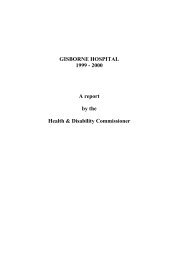09HDC01565 - Health and Disability Commissioner
09HDC01565 - Health and Disability Commissioner
09HDC01565 - Health and Disability Commissioner
Create successful ePaper yourself
Turn your PDF publications into a flip-book with our unique Google optimized e-Paper software.
Opinion <strong>09HDC01565</strong><br />
given the PCA sheet prescription <strong>and</strong> the fact that Mr A was talkative, with no signs<br />
of drowsiness or tiredness.<br />
81. RN Ms J‘s 5am entry in the progress notes states ―O2 4l via NP, sats 94% on RA<br />
[room air], 98% on 4l, due to mouth breathing whilst asleep‖. On the ―Neuroscience<br />
Documentation of Care‖, RN Ms J recorded that Mr A was having oxygen at 4L/min<br />
via nasal prongs. RN Ms J subsequently told HDC that this was an error in<br />
documentation, <strong>and</strong> that he was having oxygen at 3L/min as recorded on the<br />
―Neurosurgery Observation Chart‖. 24<br />
82. RN Ms J also notes that when a person is staying overnight in an unknown <strong>and</strong><br />
unsettled environment, it is harder for them to sleep. She states the fact that Mr A was<br />
asleep each time she approached to check his vital signs does not mean he could not<br />
open his eyes spontaneously. She notes that in her experience, it is easier to assess a<br />
person‘s pupil size <strong>and</strong> reaction to light stimulus in a darkened environment. RN Ms J<br />
states that when she assessed the power in Mr A‘s arms throughout the night, he had<br />
the same power in both arms.<br />
83. In her statement for the Coroner, RN Ms J states that she emptied Mr A‘s catheter bag<br />
at approximately 6.15am. 25 She recalls saying that she would see him that night when<br />
she was back at work, <strong>and</strong> that he replied ―Ok, I‘ll see you then.‖ RN Ms J left the<br />
room to assist her colleagues on the ward, <strong>and</strong> then to h<strong>and</strong> over to staff coming on<br />
for the morning shift. She returned to the room at approximately 6.35am to respond to<br />
a call from another patient. She recalls hearing Mr A snoring. He was due to have his<br />
next observations taken at 7am.<br />
84. RN Ms J subsequently told HDC that Mr A was able to be seen <strong>and</strong> heard by her at all<br />
times during her shift, except when she was attending to other patients. She states that<br />
the curtain around his bed space was placed so that the light from the lamp on the<br />
nurses‘ desk did not shine in his eyes, but she was able to see him ―from his nose<br />
down‖ from her sitting position at the desk. She said that by leaning forward slightly,<br />
she was also able to see his eyes. RN Ms J states that the pulse oximeter was attached<br />
at all times, the monitor was visible to her throughout the night, <strong>and</strong> the alarms were<br />
turned on but did not sound during the night.<br />
85. RN Ms J also told HDC that the oxygen monitor was set to 92% as the low default<br />
setting for all patients, set at the time of installation by the clinical nurse educator.<br />
CDHB states that this is not correct, <strong>and</strong> that the default setting for monitors of the<br />
type used for Mr A is low 90% <strong>and</strong> high 105%. It therefore considers RN Ms J may<br />
have reset the monitor. RN Ms J subsequently responded to this, stating that at no<br />
time during her years of working on the ward did she change the default settings on<br />
monitors without instruction from medical staff. She states that she did not change the<br />
settings on Mr A‘s monitor at any time.<br />
24 RN Ms J recalls it was the patient she had collected from recovery who was on 4L/min via face<br />
mask.<br />
25 Clinical records show output of 400mls in the space on the form for 7am, although the time was not<br />
filled in.<br />
15 5 September 2012<br />
Names have been removed (except Canterbury DHB <strong>and</strong> the experts who advised on this case) to<br />
protect privacy. Identifying letters are assigned in alphabetical order <strong>and</strong> bear no relationship to the<br />
person’s actual name.
















